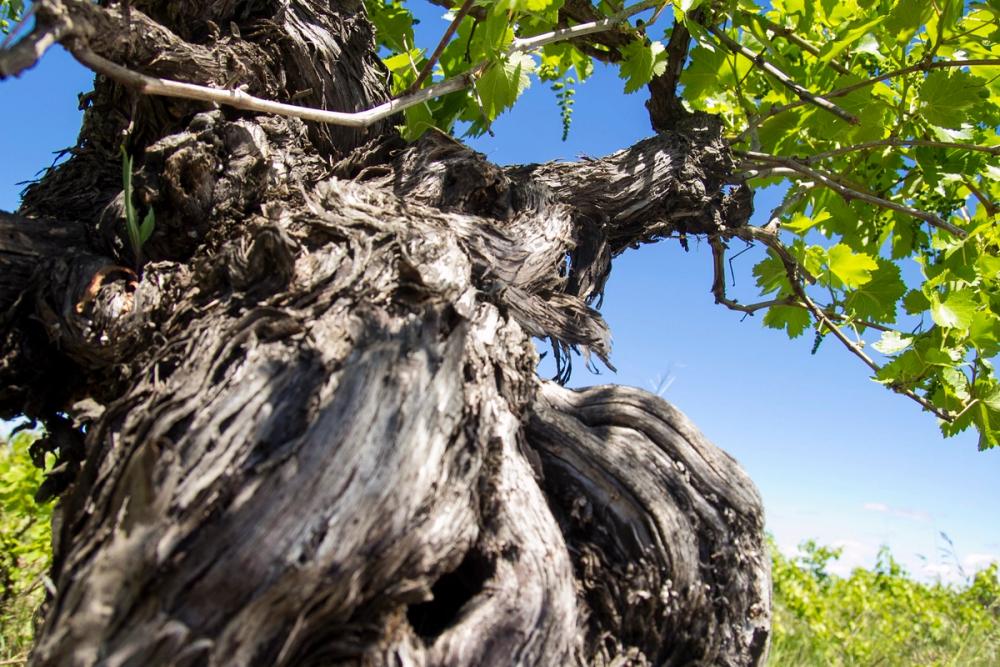What role do old vines play in the current production of Viña Morandé?
Old vines have played a role in our portfolio since Morandé was founded in 1996 – first coming to market with the launch of our Aventura wines; a Cinsault from Itata, a Carignan from Maule and at that time an old vine César Noir and Portugais Bleu.
Old vines offer the ability to fully express our Chilean terroir in unique ways, while also keeping a cultural link with small farmers rooted in the areas where they grow – particularly when it comes to varieties such as País, Cinsault, and Carignan.

Viña Morandé’s Ricardo Baettig is excited about the future role old vines have in Chilean wine
They play a huge role in our Terrior Wines range, crafted to highlight the Maule and Itata regions’ ancient traditions and small artisanal producers who maintain old head-pruned vines and represent everything Chile’s cultural heritage has to offer. Old vines allow us to produce distinctive wines; currently a Sémillon, Cinsault-País, Carménère-Malbec and a single varietal País wine - all offering full terrior expression that’s truly reflective of the very best these grape varieties have to offer from Chile.
How many old vines do you manage, and what varieties do they cover?
We manage around 52 hectares of vineyards, of which old vines based on their own roots include Carignan, Cabernet Sauvignon, País, Cinsault, Malbec and Sémillon.
We also have old vines grafted on País or Sauvignon Vert rootstocks for Grenache, Syrah, Mourvèdre, Tempranillo, Chenin Blanc and Vermentino.
How do you define an old vine in terms of years, etc?
While there are no hard rules around what constitutes an old vine, I consider them to be more than 45 years old and from a mature vineyard that’s more than 20 years old.
You are looking to work with old vines to innovate and use grafting techniques to experiment with “new” varieties - what are you doing?
I see huge potential in grafting old vines as a way of experimenting with new varietals in less ‘usual’ regions of Chile, while also adding value and promoting resilience in the vineyard.
Grafting allows us to combine the desirable traits of an old vine, with the hardiness of different rootstocks. As a result, we’re able to achieve good yields of high-quality grapes more quickly - allowing us to see results much earlier. It also potentially extends the productive life of the vines, improves overall vine health and allows us to adapt to changing climate conditions; the resilience of old vines opens an interesting look at whether they can offset some of the viticulture challenges presented by climate change.
In 2007, we successfully grafted Grenache and Syrah over País and our primary focus now is on the Itata and Maule regions. Over the past five years, we grafted some special parcels with optimal sun exposure to produce Mourvèdre, Tempranillo, Chenin Blanc, and Vermentino. We're also actively experimenting with a small section of a Montepulciano parcel, and the initial results from this grafting are promising.
Looking ahead, I see significant potential for Chenin Blanc, Mourvèdre, Vermentino, and Tempranillo in Itata. Although in limited volumes, our efforts have also allowed grapes like Vermentino to flourish in unexpected areas such as Maule. Semillon is also showing promising potential; there’s growing market demand for this variety, and strong opportunities for us to scale up.
What is the exact process involved in grafting vines?

Old vines help truly express the characteristic of the grape variety says Viña Morandé’s Ricardo Baettig
After identifying a well-established vine that’s already adapted to its soil and terroir, we cut the whole trunk at a particular height from the ground. We then insert two sticks of the new grape variety – positioning them over the living part of the old vine, known as the 'cambium' tissue. This helps the vascular system (which includes the phloem and xylem) to develop, creating a plant with an old and well-established root system as well as an above-the-ground section producing the new desired grapes.
To ensure it takes, we wrap the inserted sticks tightly in a moisture-retaining material. In the spring, buds will begin sprouting from both the new sticks and the original trunk. It’s important to leave some of the old buds for a while until we're sure the new buds are well attached, and securely connected to the old vine's vascular system.
Another grafting method we use involves cutting only into the phloem layer of one or two branches of the vine and then attaching only a bud. While this technique demands greater skill, in my experience it yields the best results.
Are there any potential risks or downsides to the vine?
There are potential risks when grafting fragile vines, especially during droughts. If not done carefully, you risk killing the vine and so it’s essential to ensure the grafted bud fully sprouts and to leave a few extra buds to grow from the lower part of the original vine.
As a wider point, we’re taking great care to identify and retain the best old vines for producing Chile’s traditional País, which we’re leaving un-grafted to retain its historical significance in Chile.
What do you hope the grafted old vines can offer you as a winemaker in terms of quality and style of wine?

Grafting old vines allows Baettig to introduce new grape varieties to a region
As a winemaker who has experience working abroad, grafting old vines has allowed me to experiment and try making wines from grape varieties that are not typically found in Chile. It provides flexibility and opens up greater potential for innovation in the vineyards, with the added advantage of saving time and seeing quality results sooner.
What economic benefit do they bring to growers and owners?
There are many potential benefits, but they still need to be proven as we’re still in the early stages. While it's crucial to maintain and improve the best País plots, I believe in the potential of grafted old vines to add value in areas with otherwise limited commercial opportunities.
By repurposing old and somewhat forgotten vines like partially grafted País, with grape varietals likely to thrive in these terriors and with better market prospects, we’re gaining a growing understanding of both the terrior and the grapes. In turn, we’re able to make high-quality wines from these grapes – creating greater value in these vineyards.
What other work is being done with old vines in different parts of Chile - particularly the work taking place in the South in offering new potential and opportunities for varieties like Cabernet Sauvignon?
Our experimental work in Southern Chile is focussed on producing Cabernet Sauvignon from the Secano of Itata Valley. Itata Valley has long been famed for its outstanding País, Muscat, Cinsault and Carignan wines, but we’re also seeing exciting potential for old vine Cabernet Sauvignon despite this region being farther south than would typically be considered for this grape variety.
We’re currently working on crafting a Cabernet Sauvignon wine from Ránquil, in Itata Province, produced from dry-farmed 125+ year old vines. Old vines in this region are producing distinctive and rare Cabernet Sauvignon wines with unique characteristics that set them apart from wines made from younger vines; they’re refined, well-structured and balanced, offering concentrated flavours, complexity, and nuanced aromas. Despite being elegant and well-structured, they’re also approachable with their softer tannins, and velvety textures.
While all regional and varietal exploration plays an important and exciting role in the future of Chilean wine, this southern old-vine Cabernet Sauvignon opportunity carries a strong promise of scalable success and commercial sustainability.
What other developments are taking place at Morandé?

Viña Morandé’s is introducing more wines from the Casablanca Valley
We’ve also just launched a new high-end premium red wine from Casablanca that further showcases the valley's ability to produce exceptional cold-climate grape variety wines. Morandé Casatinta 2020 (RRP £39.99) is a blend of Malbec, Syrah and Cabernet Franc that offers the classic floral character and vibrant fruit flavours typical of the prized Casablanca terrior. Alongside its signature floral character are pronounced notes of fresh red fruits, black fruits, and spices. The wine is elegant and balanced on the palate, has good acidity and a fine, complex structure.
How was the 2023 harvest in terms of quality and production?
The 2022–2023 season was a particularly challenging one for the Chilean wine industry, with the winter and spring conditions leading us to anticipate a later-than-usual harvest. However, the summer temperatures steadily increased from December, which rapidly accelerated the ripening process and resulted in the harvest beginning approximately seven to 10 days earlier than expected – making it intense and fast-paced (the harvest window was particularly narrow in the central valley).
Plus, we saw wildfires in mid-January (primarily in the Itata and Bio-Bío regions); more than 600 wine producers were affected, with fires destroying nearly 470 hectares of century-old vines. Thankfully, we were unaffected directly by the fires and had measures in place to manage the effects of smoke taint.
Despite a 15% reduction in volume compared to the 2022 vintage, we’ve achieved excellent quality in our 2023 wines and while our coastal wines are arguably less pungent on the nose, they’re showing greater volume and depth.
What impact will we see on pricing with regards to Chilean wines?

"We’re currently working on crafting a Cabernet Sauvignon wine from Ránquil, in Itata Province, produced from dry-farmed 125+ year old vines," says Ricardo Baettig
After a tough year, producers are pushing hard to bounce back to previous sales levels. This could result in a surge in lower alcohol wines (around 10.5%-11% ABV) aimed at the entry-level off-trade market, which risks disrupting overall quality perceptions. Conversely, the combined impact of UK duty and inflation has led to industry predictions that wines priced between £7-£8.99 will become the leading category in the off-trade, surpassing the £5-£6.99 segment.
How do you see the UK market in terms of opportunities and challenges?
There are significant UK market opportunities for high-quality wines with lower alcohol content, providing they offer a consistent quality that continues to elevate the growing quality perceptions of Chilean wine.
The challenge then arises around how traditional ABV wines retain their loyal customer base given the competitive nature of the UK wine market, pricing pressures and growing popularity of lower alcohol options. There’s also the challenge of determining what appeals to younger consumers when it comes to wine.
How are you working in the UK to make the most of the opportunities?
We’ve built our business to be a one-stop solution for the industry, developing various strategies tailored to each brand, importer, and distribution channel.
We’re not afraid to challenge what is expected of a Chilean wine brand, using innovation to push the possibilities as far we can to offer the most comprehensive wine range from the region. This means predicting what people want, being flexible and innovating at speed to maximise the opportunities.
When it comes to retaining loyal customers to our traditional ABV wines, we’re focussed on exploring new regions, recovering heritage varieties, experimenting with new varietals, and making new and surprising blends. We also use a combination of new and old fermentation and aging vessels to offer the truest Chilean expression, as well as offering a Chilean-terrior take on popular varietals like Malbec and Pinot Grigio.
When it comes to exploring what appeals to younger consumers, we pride ourselves on staying agile and responsive to evolving trends whether that’s different formats, RTDs, NPD, or something else.
Most importantly, across everything we do, we’re not afraid to try and fail – because we only then do we learn.
* You can find out more about Viña Morandé at its website here.
































